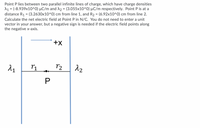Question

Transcribed Image Text:Point P lies between two parallel infinite lines of charge, which have charge densities
11 = (-8.939x10^0) µC/m and 12 = (3.055x10^0) µC/m respectively. Point P is at a
distance R1 = (3.2630x10^0) cm from line 1, and R2 = (6.92x10^0) cm from line 2.
%3D
Calculate the net electric field at Point P in N/C. You do not need to enter a unit
vector in your answer, but a negative sign is needed if the electric field points along
the negative x-axis.
+x
r2
Expert Solution
This question has been solved!
Explore an expertly crafted, step-by-step solution for a thorough understanding of key concepts.
Step by stepSolved in 2 steps with 2 images

Knowledge Booster
Similar questions
- Figure 4 shows a section of a long, thin-walled solid infinitely long metal tube of radius R = 5.00 cm , with a charge per unit length of λ = 2.00 ×10−8C/m . What is the magnitude of the electric field at radial distancearrow_forwardA solid sphere of radius 40.0 cm has a total positive charge of 31.7 µC uniformly distributed throughout its volume. Calculate the magnitude of the electric field at the following distances. (a) 0 cm from the center of the sphere 0 ✓ kN/C (b) 10.0 cm from the center of the sphere 445.78 kN/C ✓ (c) 40.0 cm from the center of the sphere 1783.12 ✓ kN/C (d) 59.0 cm from the center of the sphere kN/C Need Help? Read It Watch Itarrow_forwardA thin, metallic, spherical shell of radius a = 5.0 cm has a charge qa = 4.00×10-6 C. Concentric with it is another thin, metallic, spherical shell of radius b = 10.00 cm and charge qb = 6.00×10-6 C. a) Find the electric field at radial points r where r = 0.0 cm. b)Find the electric field at radial points r where r = 7.5 cm. c)Find the electric field at radial points r where r = 15.0 cm. d)Discuss the criterion one would use to determine how the charges are distributed on the inner and outer surface of the shells. What is the charge on the outer surface of the outer shell?arrow_forward
- A point charge of -3.00 μC is located in the center of a spherical cavity of radius 6.90 cm inside an insulating spherical charged solid. The charge density in the solid is 7.35 × 10-4 C/m3 . Calculate the magnitude of the electric field inside the solid at a distance of 9.10 cm from the center of the cavity. Express your answer with the appropriate units. E=__arrow_forwardA charge of -90.4 uC is placed on spherical conductor of radius 10.0 cm. Part (a) What is the magnitude, in newtons per coulmb, of the electric field due to this charge at a distance of 1.32 cm from the center of the sphere? E=_____ N/C. Part (b) What is the magnitude, in newtons per coulmb, of the electric field due to this charge at a distance of 7.08 cm from the center of the sphere? E= ______ N/C Part (c) What is the magnitude, in newtons per coulmb, of the electric field due to this charge at a distance of 17.1 cm from the center of the sphere. E= _______ N/Carrow_forwardElectric charge is distributed over the disk a2 + y < 20 so that the charge density at (x,y) is o(x, y) = 5 + x² + y² coulombs per square meter. Find the total charge on the disk.arrow_forward
- Consider a thin, spherical shell of radius 16.0 cm with a total charge of 29.8 µC distributed uniformly on its surface. (a) Find the electric field 10.0 cm from the center of the charge distribution. magnitude Is the point 10 cm from the center inside or outside the sphere? MN/C direction (b) Find the electric field 25.0 cm from the center of the charge distribution. magnitude MN/C directionarrow_forwardCharges q1 and q2 are located on the corners of a rectangle. If width w=60 cm and length l=80.2 cm find the magnitude of the electric field (in N/C) at P when q1= 4.08 nC and q2=1.43 nC.arrow_forwardAn infinitely long cylinder of radius R = 57 cm carries a uniform charge density ρ = 21 μC/m 3. Calculate the electric field (in N/C) at distance r = 19 cm from the axis of the cylinder.arrow_forward
- The charges in the figure are q1=q2= +e and q3=+2e. The distance a= 6.00μm. a) The horizontal component of the net electric field at point P is: _____i N/C. b) The vertical component of the net electric field at point P is:______j N/C. c) The magnitude of the net electric field at point P is:_____ j N/C. d) La dirección del campo Eléctrico neto en el punto P respecto al eje x+ es:______°arrow_forwardA cylinder of length L=5m has a radius R=2 cm and linear charge density 2=300 µC/m. Although the linear charge density is a constant through the cylinder, the charge density within the cylinder changes with r. Within the cylinder, the charge density of the cylinder varies with radius as a function p( r) =p.r/R. Here R is the radius of the cylinder and R=2 cm and p, is just a constant that you need to determine. b. Find the constant po in terms of R and 2. Then plug in values of R and 1. to find the value for the constant p. c. Assuming that L>>R, use Gauss's law to find out the electric field E inside the cylinder (rR) in terms of 1. and R. d. Based on your result from problem c, find the electric field E at r=1cm and r=4cm.arrow_forwardFind the flux in N.m².C-1 of a constant electric field E = (5.3180x10^3) i + (-5.514x10^3)j + (-1.5880x10^3) k N/C, passing through an area defined by the area vector A = (-4.7990x10^0) i + (-7.69x10^0) j + (4.2900x10^-1) k m².arrow_forward
arrow_back_ios
SEE MORE QUESTIONS
arrow_forward_ios